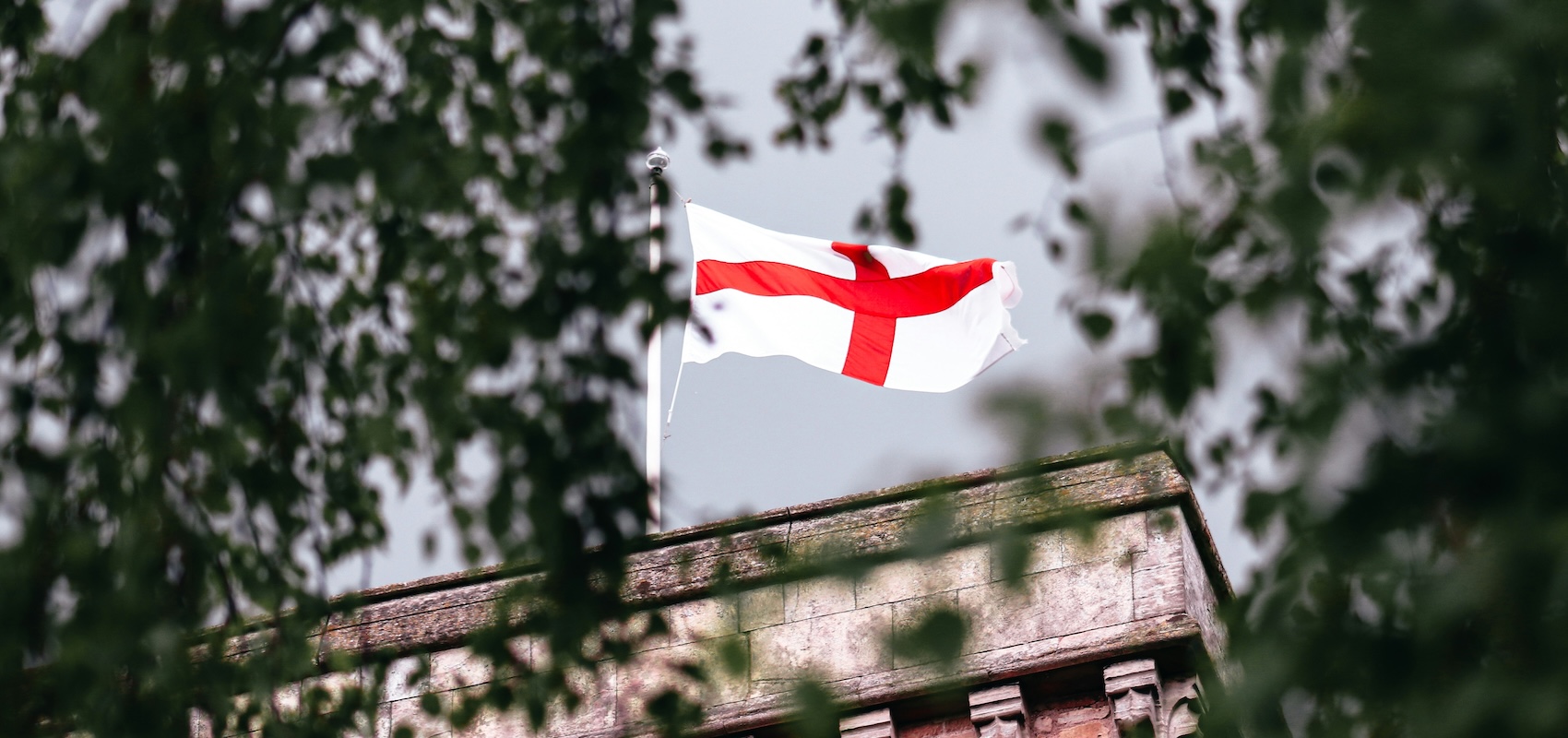
In recent weeks, the Flag of St. George (a red cross on a white background) has appeared throughout England, painted (with more or less skill and care) on everything from roundabouts to vehicles and pedestrian crossings. But what is the origin of this symbol, and how did it become England’s national flag?
What we think of as flags originated in the Middle Ages as coats of arms and banners carried into battle, which were associated not with a nation but with personal allegiance to a monarch or leader. The coat of arms of a king or nobleman would be worn as “livery” by his personal servants and officials, just as a literal “coat of arms”—a surcoat or tabard bearing the heraldic symbols—is still worn today by heralds in Britain and Canada. Heraldry—the study and design of coats of arms—began in the twelfth century and took off in the thirteenth. The mania for assigning coats of arms to everyone extended to past national heroes, saints, and even God. This was how St. George came to acquire a coat of arms. In time, it would become a flag.
It is likely that the association between St. George and a red cross on a white field (“argent a cross gules,” in heraldic language) began in the twelfth century—and not in England, but in the Republic of Genoa, which flies a flag identical to England’s. But the red cross on white was at this time already a symbol of crusaders; a would-be crusader would wear a white cloak (symbolic of purity) and “take the cross” (a vow to wage war against the infidel), symbolized by a red cross sewn to his cloak. The red cross became the symbol of the Knights Templar and other crusading orders, and St. George became an unofficial patron of crusaders.
While English kings from Richard the Lionheart onward were often eager to associate themselves with crusading, the cross of St. George came into its own in the reign of Edward I (1272–1307), whose wars with the Scots and Welsh sharpened the idea of a distinctly English identity. In the 1290s, Edward had his soldiers wear armbands bearing “the arms of St. George,” although this coat of arms was understood as a personal flag of the monarch marking allegiance to him. It was not the only personal flag borne into battle for Edward; the banners of St. Edmund and St. Edward were accorded equal significance.
But the cross of St. George had the advantage of being unmistakable in the heat of battle, and the outbreak of the Hundred Years’ War in 1337 supercharged the search for a distinctive symbol of English arms. In 1345–46, Edward III’s armorer commissioned eight hundred “pennoncels” (little pennants) of St. George’s arms to be carried on lances, while pennons bearing the red cross began to be flown from the topmasts of English ships. What had been a royal livery and a helpful signal in battle was beginning to evolve into something like a national flag.
With Edward III’s institution of the Order of the Garter in 1348 (perhaps inspired by the Hungarian Society of St. George, founded in 1325), the cross of St. George overcame competing symbols to become the primary emblem of English monarchy. But it was at the Battle of Agincourt in 1415 that the flag itself became an icon. According to a chronicle of the time, the Brut, Henry V literally rallied his men to the banner of St. George: “In the name of Almyghti God and Saynt George, avaunt banarer! And Saynte George, this daye thyn help!” Long before William Shakespeare seized upon the scene for his drama, St. George’s cross had come to signify England and Englishness as well as just the crown; the hero of Agincourt was the ordinary English bowman. This plebeian resonance was magnified in the English Civil War when the plain cross of St. George became the symbol of Parliament.
To this day, the United Kingdom has no official national flag and no flag law. Technically, the Union Flag remains a personal flag of the monarch, akin to the royal standard (which was why Elizabeth II initially refused to lower the Union Flag to half-mast over Buckingham Palace when Princess Diana died in 1997). The flag of St. George has even less official status; it has been associated primarily with national sporting events, although in recent years civic celebrations of St. George’s Day on April 23 have increased in number. Ancient yet unofficial, the flag of St. George is associated above all with England’s independent-minded people, rather than with any dynasty or state.
